|
Candidate
Team Projects - 2019
Team
Projects are for suitable for teams of students (typically 3) taking the
course for three credit units.
These projects
will be "pitched" in class on Thursday, January
10th
Project
contacts are listed on the handout distributed on the first day of
class.
"Recommended
Skillset" is dependent on the selected design concept.
Team Project Titles:
(year originally suggested)
-
- Project with VA Palo Alto
Health Care System's Assistive Technology Lab
- Get a Grip
Project (2017)
Back to top
Projects with
Abby 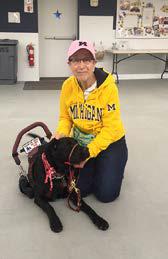
-
Background: Abby is an
artist, a retired art teacher (grades K-College), a psychiatric social worker,
and a computer graphic designer. She is an individual with multiple
disabilities: a mobility challenge, a bipolar disorder, and a visual
impairment. She is passionate about making a difference and advocating for
individual rights. She has been a chair of the
Consumer
Advisory Council and formerly represented consumers on the Board of
Directors of NAMI (National Alliance on
Mental Illness) in Santa Clara County and has volunteered in their
Connection
Recovery Support Group and the
Peer
PAL Program. She has also volunteered for the
Vista Center for the Blind and Visually
Impaired, has been on the
Board of Directors
of the Silicon Valley Independent Living
Center (SVILC), has successfully been involved in litigation to preserve
the rights of service dog recipients when they are hospitalized, and has
presented Poster Sessions and spoken at conferences including NAMI's National
Convention, California ADA (Americans with Disabilities Act) 2015 Conference
celebrating 25 years and the California Council of the Blind's Annual
Convention. Abby has recently acquired a new service dog, Nathan, from
Canine Partners for Life (CPL) in
Cochranville, PA. She has also joined their Advisory Council.
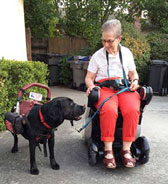 Back to top Back to top
Projects for Abby's Wheelchair
- 1.
Enhanced Visibility Project
-
Background: "The WHILL does
have some rear lights, but no real way to illuminate my path for early morning
or late afternoon activities such as walking my dog or going out at night. This
is a real problem when you consider where there are van accessible parking
spaces and locations of activities. A movie and restaurant outing with may
include parking one place, and meeting friends in a location a block or so
away. Lighting is not always available in parking lots, and many time parking
lots are located in back of buildings. Adequate lighting means the difference
between safe maneuvering both me and my dog wherever I want to
go."
-
Problem: Abby's new
wheelchair has limited lighting which creates a safety hazard while walking
Nathan in the early morning or traveling at night.
-
Aim: Explore ways to enhance
the night time visibility of Abby's wheelchair.
- 2.
Storage Project
-
Problem: Abby's new
wheelchair has no provision for storing personal items or transporting
groceries.
-
Aim: Explore ways to add a
personal secure storage space and facilitate grocery transportation and
handling.
-
Other:
Photos
- 3.
Backpack Project
-
Background: "Prior to
receiving my WHILL Model M power
chair, I had the opportunity to use the
Model
A. The back of the Model A has an area behind the seat back to easily
attach a backpack to carry my items: a 13” laptop computer, 2 insulated
water containers (one for myself and one for my service dog), insulated lunch
box, food for my dog, hand cleaner, case to safely carry my computerized
electronic glasses, other dog-related items, large print calendar, and other
necessities depending on my planned daily activities."
"The Model M has a much more
integrated and reinforced seat back than the Model A. The ergonomic back
cushion overlaps the reinforced back support in such a way that doesn’t
have the same ease of attaching and accommodating a substantial backpack. The
only way I have found to attach the backpack is over the back of the
seat."
-
Problem: "The backpack's
shoulder straps that come over the seat back are painful to sit against and
defeat the ergonomic features of the wheelchair."
"Besides the straps going over the
front of the seat, there is a short piece that has a clasp that pinches
together to hold the straps in place. That piece also digs into my back. I have
tried not connecting it, and then the backpack isn't secure, doesn't stay in
place, and if there are heavy items in the backpack it isn't safe moving around
with it."
-
Aim: Explore solutions for
accommodating a backpack (or other storage product) that eliminates sitting
against straps.
-
Other:
Photos
Back to top
Projects for Abby's Service Dog, Nathan
- 1.
Simultaneous Operation Project
-
Background: "Canine Partners
for Life has made some modifications with flexi leashes for powerchair users.
The design of the WHILL does not lend itself to this kind of modification.
Operating the WHILL while controlling a dog with a leash is a real challenge.
The leash has to be able to go on either side, or in front and back of the
chair, while at the same time be short enough to not get caught in the front
wheels, or the arm rests. I was recently at IKEA, and the leash I was using got
twisted around one of the front wheels under the wheel cover. This is a
dangerous situation for me as well as my dog. As my service dog is with me
wherever I go, this presents a continual problem in our lives."
-
Problem: Wheelchair and
scooter users like Abby can have a difficult time simultaneously operating
their mobility device and controlling their service animal.
-
Aim: Explore ways to make it
easier for Abby to operate her wheelchair and control Nathan.
- 2.
Harness Project
-
Background: "Nathan’s
harness has three clasps to attach 'fuzzies' under his belly, and both front
legs as well as a 'gentle leader' around his muzzle. This requires daily
opening and closing of these clasps during putting on and taking off the
harness. With hand difficulties the pinching of the clasps is extremely
difficult."
-
Problem: Individuals like
Abby who do not have a strong grip may experience difficulties with buckling
and unbuckling their service animal's harness, especially while seated in their
mobility device.
-
Aim: Explore ways to make it
easier for Abby to put on and take off Nathan's harness.
-
Other:
Photos
-
Overall Design Criteria:
- The design should not alter or
permanently deface or damage the physical structure of the
wheelchair.
- The customization should be able
to easily be installed, removed, changed, cleaned, and washed by the
user.
- The design should work on a
number of popular / standard scooters covered by insurance and
Medicare.
- Consider different user personas
and aesthetics (e.g. refined / elegant, modern / contemporary, smart / sporty,
premium / luxury, male / female, as well as the age of user, etc).
- Consider fabrics, metal
finishes, colors, patterns, lights, textures, and text elements.
- Consider a variety of usage
occasions (e.g. in-home, outdoors, party, tailgater, etc).
- The design should be inexpensive
and easy to fabricate.
- Consider designs that would
enhance wheelchair visibility at night, especially when crossing
streets.
-
Recommended Skillset:
Mechanical Engineering
-
Links:
Back to top 
Projects with June
Clean House Project
-
Background: June is an older
adult who uses a rollator for balance and stability when moving around her San
Francisco home.
-
Problem: June's use of her
rollator makes it difficult for her to perform home cleaning tasks
independently.
-
Aim: Explore designs to
provide a safe, effective, and independent means of performing common household
cleaning tasks.
-
Design Criteria: The
solution must be safe to use, easy to operate, and be compact to
store.
-
Other: Visits to June's home
in San Francisco will be required.
-
Recommended Skillset:
Mechanical Engineering
-
Links:
Back to top
Within Reach Project
-
Background: June is an older
adult who increasingly finds that items in her upper kitchen and closet shelves
are now out of her reach.
-
Problem: Currently available
step stool solutions do not meet her needs: some are too tall, others have a
stepping area that is too small, and most do not have hand-holds to provide
needed balance and stability during reaching. Finally many step stools are
heavy and bulky, making them difficult to move and position.
-
Aim: Explore designs to
provide a safe and stable means of accessing items on upper
shelves.
-
Design Criteria: The
solution must be easy to move and position, offer a sense of security during
use; have a wide, non-slip surface; provide the proper height advantage; and be
collapsible for storage.
-
Other: Visits to June's home
in San Francisco will be required.
-
Links:
Back to top
Project with
Tony 
Lap
Extender
-
Background: Users of manual
wheelchairs - such as Tony - employ their hands, arms, and shoulders to propel
themselves, achieving mobility. However, there are times their hands are needed
to hold and carry items.
-
Problem: There are tasks
performed by users of manual wheelchairs that require concurrent propulsion and
the ability to hold items, such as food from a buffet line.
-
Aim: Explore designs for a
wheelchair accessory that will not interfere with propulsion while carrying
important items.
-
Design Criteria: The Lap
Extender should be:
- large enough to hold a tray of
food
- large enough to hold a 13"
laptop
- not so large as to interfere
with propulsion
- deployed as needed, stowed when
not needed (to facilitate transfers)
- cool-looking
- compatible or adaptable to a
variety of manual wheelchairs
- composed of low cost
materials
- easy to fabricate
- durable
- easy to install, remove,
cleaned, and washed by the user
- waterproof and
food-proof
- not alter or permanently deface
or damage the physical structure of the wheelchair
-
Other: Interactions with
Tony, who lives in Mountain View, must occur on the weekends.
-
Recommended Skillset:
Mechanical Engineering, Shop
-
Links:
Back to top
Project with
Fernanda 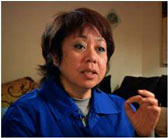
Easier WHILL Recharging
-
Background: Fernanda enjoys
the mobility and style her WHILL Model M wheelchair provides.
-
Problem: Charging the
wheelchair is a challenging activity as its port is in an inaccessible location
and Fernanda does not have a strong grip, making it difficult to handle the
charging cable and plugging it into the port.
-
Aim: Explore designs to
improve Fernanda's WHILL charging experience.
-
Design Criteria:
- The design must not alter the
wheelchair: no drilling new holes
- The design must be removable,
restoring the wheelchair to its original condition
- The design must match WHILL's
aesthetics
- The design must provide Fernanda
an easy way to grip the charger cable and insert the connector into the
wheelchair's charging port.
-
Other:
-
Recommended Skillset:
Mechanical Engineering, Soldering, Shop
-
Links:
Magical Bridge Playground
-
Overview: The Magical Bridge
Playground is the nation's first fully accessible and socially inclusive
playground. It is a public space where children with disabilities as well as
children of parents who have a disability can play together. The City of Palo
Alto designated 1.3 acres of underutilized public land in Mitchell Park,
located at
600
East Meadow Drive in Palo Alto, for the site of the Magical Bridge
Playground - adjacent to Abilities United and close to the new Mitchell Park
Library.
-
The
playground
opened in April 2015 and has been overwhelmingly popular with both kids and
parents, with some families traveling long distances to experience
it.
-
After the Playground was completed,
the Magical Bridge Foundation
was created to assist other communities in building their own innovative and
inclusive playgrounds. Construction on a Playground in Redwood City begain in
the Fall of 2017, and funds are currently being raised for Magical Bridge
Playgrounds in Sunnyvale and Morgan Hill.
Back to top
Project with Jay at the
Magical Bridge Playground
Playground Equipment for Students with Learning Disabilities and
Challenges in Speech & Language
-
-
Problem: While the
park's play equipment has been well-received, Magical Bridge Playground now
seeks to use play to benefit students with specific learning disabilities and
challenges related to speech & language, the two most common disabilities
among the school-age population. It is thought that non-traditional learning
strategies and experiences using play equipment could benefit this population
of students.
-
Aim: Explore designs to
create new play and educational experiences incorporating multiple senses and
actions for all playground users and visitors that could also have positive
outcomes for those with learning disabilities and challenges in speech &
language.
-
Design
Criteria:
- Designs should be durable,
fun, safe for everyone, accommodating to youth and parents with disabilities -
and magical.
- Project prototypes could be
scale models to facilitate their construction and transportation.
- Designs that incorporate
electronics should be low-voltage or solar-powered.
-
Recommended Skillset:
Mechanical Engineering, Mechatronics, depends on selected design
concept
Back to top
Project with Olenka at the
Magical Bridge Playground
Playground Equipment along the Fence
-
-
Problem: The area on and
along the playground fence is under-used and could accommodate new play
equipment.
-
Aim: Explore designs to
create new play and educational experiences along the fence that incorporate
multiple senses, actions, and outcomes for all playground users and visitors,
especially those with visual impairments and diminished fine motor
skills.
-
Design
Criteria:
- Designs should be durable,
fun, safe for everyone, accommodating to youth and parents with disabilities -
and magical.
- Project prototypes could be
scale models to facilitate their construction and transportation.
- Designs that incorporate
electronics should be low-voltage or solar-powered.
-
Recommended Skillset:
Mechanical Engineering, Mechatronics, depends on selected design
concept
-
Links:
Back to top
Projects with
Angie 
-
Background: Angie is an
undergraduate Stanford student studying English with Spinal Muscular Atrophy
(SMA) who uses a powered wheelchair to get around campus.
Elbow Lifter
-
Problem: Angie requires
assistance to move her arm from her wheelchair to the table before she is able
to feed herself independently.
-
Aim: Explore device designs
that would enable Angie to feed herself completely
independently.
-
Design Criteria:
- Angie must be able to initiate
operation of the device.
- Installation of the device must
not damage or deface her wheelchair.
-
Other:
-
Recommended Skillset:
Mechanical Engineering
-
Links:
Back to top
Elevator Button Pusher
-
Problem: Angie is not able
to reach the buttons to call elevators as well as the floor select buttons
inside the elevator cars, nor does she have enough strength to push
them.
-
Aim: Explore device designs
that would enable Angie to ride elevators independently.
-
Design Criteria:
- Angie must be able to initiate
operation of the device.
- Installation of the device must
not damage or deface her wheelchair or interfere with her ability to operate
it.
- The device must not increase the
wheelchair's width.
-
Other:
-
Recommended Skillset:
Mechanical Engineering
-
Links:
Back to top
Project with
Danny 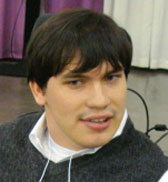
Laptray for Danny
-
Background: Danny has
cerebral palsy, a cortical vision impairment, reduced arm range of motion, and
limited hand dexterity. He uses a manual wheelchair to get
around.
-
Problem: Danny's wheelchair
does not have a laptray or a place to store items such as his cell phone,
clothing, wallet, and plates of food. Items placed on his lap usually fall off
when he propels his wheelchair.
-
Aim: Explore ways for Danny
to easily access and store his personal items on his wheelchair and retrieve
them when they fall to the floor.
-
Other:
-
Recommended Skillset:
Various, depends on chosen solution
-
Links:
 Back to top Back to top
Project with Donna
Donna's Pick Me Up
-
Background: Donna is a
congenital quadruple amputee who was born with no arms and short legs. Her
parents encouraged her to try anything and everything, and she has stayed true
to that driving force throughout her life. She came up with the idea to do a
television show about people with disabilities in 1976. She moved to California
to attend De Anza College, where in 1988 she started the community access
television program, On the Move, a show about promoting understanding,
awareness, and self-esteem for people with disabilities. has lived on her own
since 1977, displayed artwork at various shows, worked at Hewlett-Packard for
16 years as a computer analyst, and is an avid gardener and animal lover with
two dogs and a pet bird.
-
Problem: Donna reports that
she is unable to pick up objects from the floor.
-
Aim: Explore design
solutions that would enable Donna to retrieve items from the
floor.
-
Design Criteria: The device
must be:
- able to be stowed out of the way
when not needed
- easy to use
- effective in picking up small
objects
-
Other:
-
Recommended Skillset:
Mechanical Engineering, Shop
-
Links:
Back to top
Projects with
Amy 
Wheelchair Dancing
-
Background: There is
considerable medical support documenting the positive health benefits of dance
and movement for people experiencing stress-related physical and psychological
symptoms, pain, depression, cardiovascular disease, dementia, Parkinson's
disease, diabetes, cancer, and other conditions - promoting emotional, social,
cognitive, and physical well-being, as well as an enhanced quality of life.
Movement / Dance classes are offered at many Senior Centers.
-
Problem: Individuals who use
wheelchair are unable to "dance" in the traditional sense and some older adults
who don't use wheelchairs may experience balance issues that may affect their
ability to stand, walk, or move safely. However, with encouragement, they can
all engage in dance while seated through movement of the body parts they can
control: head, neck, arms, hands, torso, and feet.
-
Aim: Explore designs to
provide encouragement and enhance the dance experience for both wheelchair
users and individuals who can not stand for long periods.
-
Design Criteria:
- the design should not
permanently alter the user's chair or wheelchair
- the design should be
portable
- the design may be
battery-powered
- the design may provide
encouragement and attention in multiple ways
-
Other:
-
Recommended Skillset:
Mechatronics, Mechanical Engineering, Shop
- Links:
Organizations:
Medical Conditions:
Cancer
Dementia
Cardiavascular Disease
Arthritis
Older Adults
Chair
and Wheelchair Dancing:
Back to top
Creative Expression using an Instrumented
Wheelchair
-
Background: Most everyone
has a desire to be creative through activities such as writing, painting,
sculpture, pottery, jewelry, quilting, photography, singing, dancing, and
music.
-
Problem: Existing tools
supporting creativity are often lacking for people with disabilities. Movement
difficulties may prevent an individual from fully participating in their chosen
activity.
-
Aim: Explore ways to enhance
creative expression for people with disabilities, especially those who use
wheelchairs. This could include the creation of new activities or fabrication
of new tools.
-
Design Criteria:
- The design should express the
user's creative nature as a visible or audible output
- The design should not
permanently alter the user's chair or wheelchair
- The design should be
portable
- The design should be
battery-powered
-
Suggestions:
- Convert the user's existing
assistive technology device (such as their wheelchair) into a creative
"paintbrush" or "musical instrument" or "light show"
- Use non-traditional inputs such
as the user's residual movements or wheelchair motion
-
Other:
-
Recommended Skillset:
Various, depends on chosen solution
-
Links:
Back to top
Project with
Nick 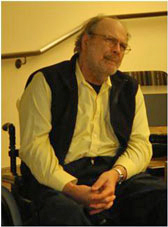
The Hide-Away Lap Tray
-
Background: Nick is an
active older adult who uses a manual wheelchair. His daily tasks include
writing in a notebook and typing on a keyboard.
-
Problem: As with most
wheelchair users, Nick experiences problems keeping items on his lap without
having them fall to the ground. Example items include books, magazines, papers
of many kinds, as well as his headset, checkbook, tin of mints, and
charger.
-
Aim: Explore designs that
address Nick's problem.
-
Design Criteria: The design
must:
- be compact as there is no space
to stow a traditional lap tray
- be easy to deploy and
stowed
- be about 8 to 10 inches from
front to back
- provide a firm, non-slip surface
to support a notebook or keyboard
-
Other:
-
Recommended Skillset:
Mechanical Engineering, Shop
-
Links:
Back to top
New Project title
-
Background:
-
Problem:
-
Aim:
-
Design Criteria:
-
Other:
-
Recommended Skillset:
-
Links:
Back to top
New Project title
-
Background:
-
Problem:
-
Aim:
-
Design Criteria:
-
Other:
-
Recommended Skillset:
-
Links:
Back to top
Project with VA Palo Alto
Health Care System's Assistive Technology Lab
Get
a Grip Project
-
Background: A handbike is a
hand pedaled bicycle designed for people without the ability to pedal with
their legs. The Freedom Ryder is the first high performance hand-powered
bicycle. Users of this recreation and racing product have set distance, speed,
and time records. The model FRH-1Q350X optionally features a forearm actuated
brake or the James Watson Quadgrips, a "forearm actuated brake lever" that
operate without the need to grip or squeeze a control.
-
Problem: Although some
veterans with spinal cord injuries may be able move their arms, they may not
have the ability to form a strong grip, preventing them from efficiently
"pedaling" their handbikes.
-
Aim: Explore designs that
would enhance a handbike user with quadriplegia's ability to pedal the Freedom
Ryder.
-
Design Criteria:
- the design could be a
replacement hand grip assembly or an accessory that fits over the current
handgrip
- no structural modifications to
the handbike
- no drilling into the
frame
- optionally fits multiple
handbike models
-
Other:
-
Recommended Skills:
Mechanical Engineering, Shop
-
Links:
Back to top
Projects Suggested by
Dave:
Creative Expression
-
Background: Most everyone
has a desire to be creative through activities such as writing, painting,
sculpture, pottery, jewelry, quilting, photography, singing, dancing, and
music.
-
Problem: Existing tools
supporting creativity are often lacking for people with disabilities. Movement
difficulties may prevent an individual from fully participating in their chosen
activity.
-
Aim: Explore ways to enhance
creative expression for people with disabilities. This could include the
creation of new activities or fabrication of new tools.
-
Suggestions:
- Convert the user's existing
assistive technology device into a creative "paintbrush" or "musical
instrument"
- Use non-traditional inputs such
as residual movements or brain waves
- Adapt or create instruments for
musicians with disabilities
- One-Handed Musical
Instrument (OHMI) Competition
-
Other:
-
Recommended Skillset:
Various, depends on chosen solution
-
Links:
Back to top
Designing Your Afterlife
-
Background: Death is the
most severe form of disability as one is no longer able to interact with people
or physical objects in the living world. What remains are only frozen static
artifacts - images, writings, and the recollections of others. Gone are one's
personality, beliefs, expertise, humor, vision, memories, insights, and
intellect.
-
Problem: With one's passing,
it is impossible to provide a full and accurate representation of whom they
were, what they believed in, and how they acted. The recollections of family
and friends fade and disappear with time, leaving the departed one's legacy at
the mercy of the living.
-
Aim: Explore ways to
preserve one's essence after death. In the technology extreme, this might
manifest itself as an interactive system that responds to queries, retells
stories, relates experiences, shares expertise, and expresses humor. The
pre-dead user would be able to create and program his / her eternal
computer-based persona before her / his demise.
-
Other:
-
Recommended Skillset:
Various, depends on chosen solution
-
Links:
Back to top
Student-defined Team Projects
- Meet with course instructor to
discuss and agree upon the specifics of the project. Interview, observe, and
discuss assistive technology problems with an individual with a disability or
older adult. Address their desire to participate in one of the following
activities by designing an adaptation to an existing device / tool or creating
a new, more useful one. Projects could address:
-
-
Activities of Daily
Living - cooking, showering or bathing, dressing, cleaning, housework, yard
work, employment, education, shopping, commuting, etc
-
Sports and Exercise -
walking, running, indoor and outdoor sports, etc
-
Leisure Activities and
Hobbies - collecting, model making, crafts, board games & videogames,
etc
Back to top
Other project
ideas
- Project Coach:
- David L. Jaffe, MS
Back to
top |